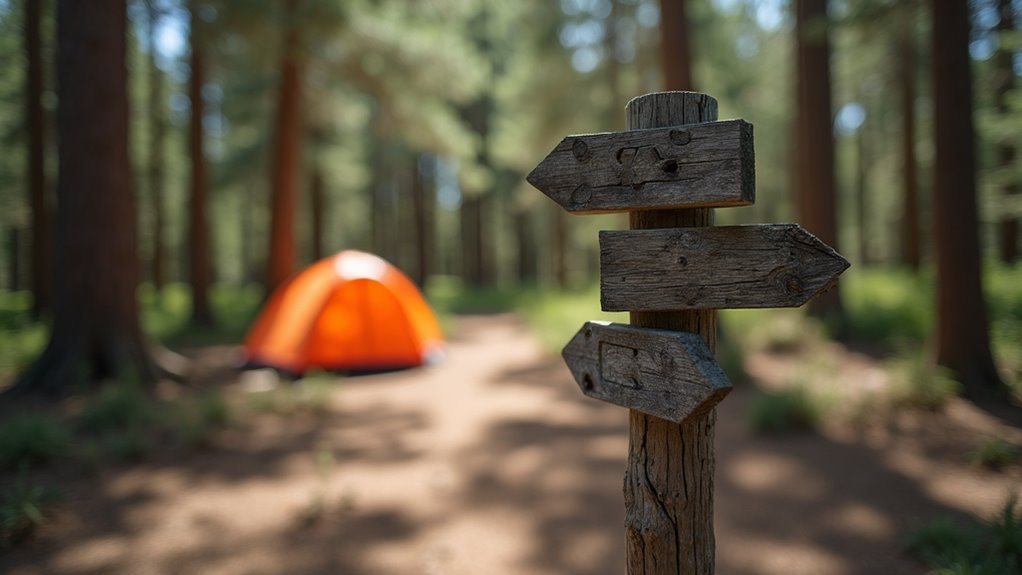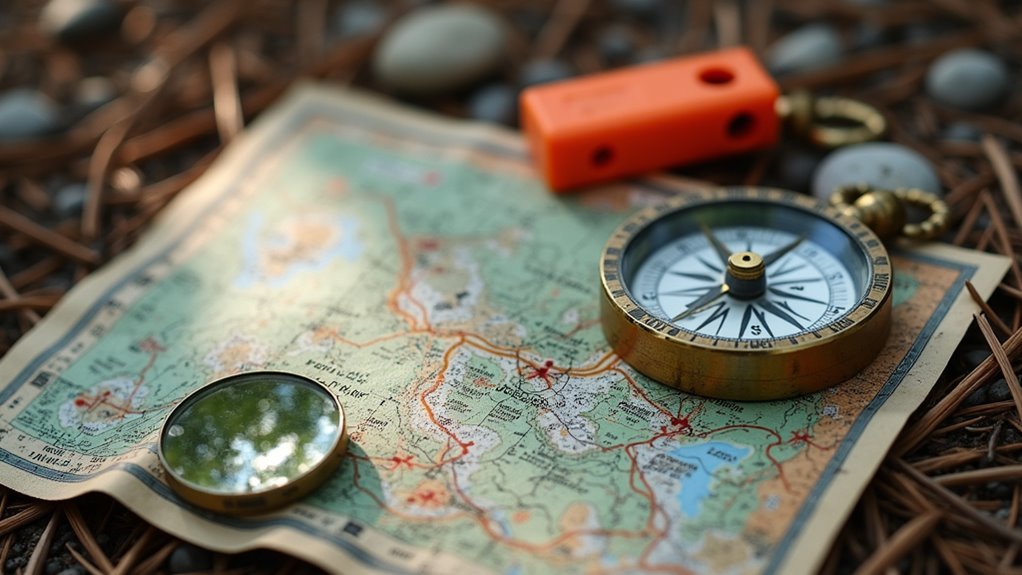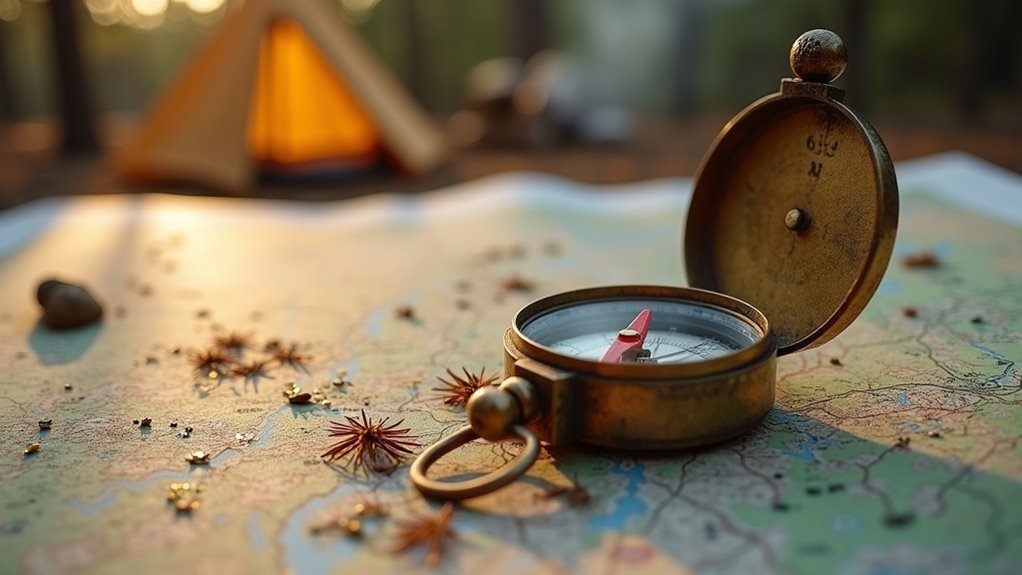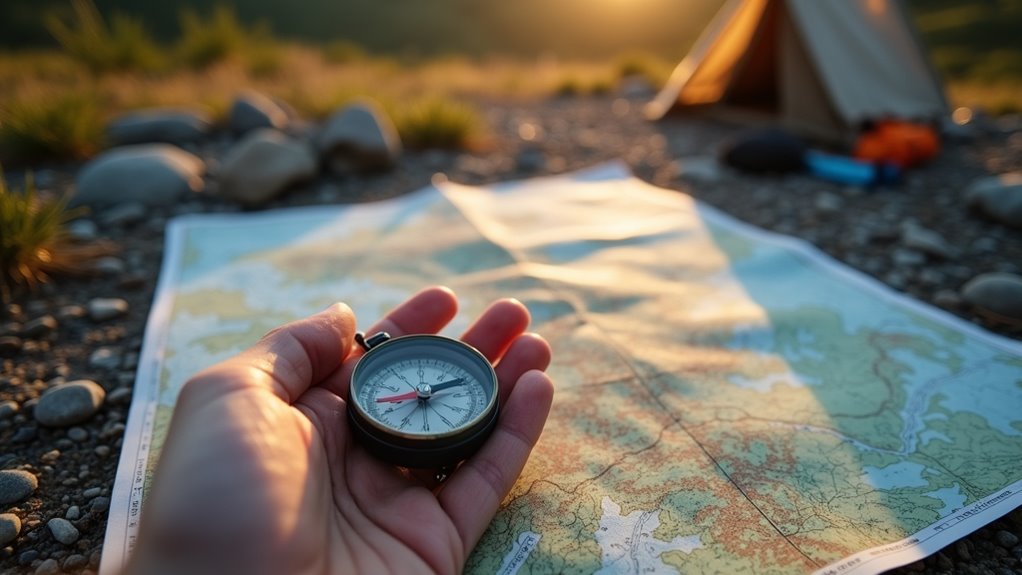Physical Address
304 North Cardinal St.
Dorchester Center, MA 02124
Physical Address
304 North Cardinal St.
Dorchester Center, MA 02124

How can basic map and compass skills outperform expensive GPS devices when you're miles from civilization and your battery dies?
You don’t need expensive gadgets to navigate confidently in the wilderness—basic map and compass skills will serve you better than any smartphone when you’re miles from cell towers. While GPS devices offer convenience, they’re useless with dead batteries or poor signal coverage. The real secret lies in combining old-school techniques with modern tools, creating multiple backup systems that’ll keep you oriented no matter what goes wrong. Here’s how smart campers build navigation confidence without breaking the bank.

When you’re deep in the wilderness, your smartphone’s GPS might fail you, leaving you stranded without a reliable way back to camp. That’s why you need backup navigation tools that don’t depend on batteries or cell towers.
Smartphone GPS can fail in remote areas, making battery-free backup navigation tools essential for wilderness safety.
A quality compass is your most important tool. Choose one with a clear baseplate and adjustable declination. Pair it with topographic maps of your area – they’re cheap and show terrain features your phone can’t. Learn basic triangulation before you leave home.
Consider a handheld GPS device as secondary backup. They’re more reliable than phones and have longer battery life.
Add a whistle for emergency signaling and reflective tape to mark your trail. These simple tools cost under $50 total but could save your life.
Remember that proper navigation is just one aspect of campsite selection, and having the right tools will help you safely explore potential camping locations in unfamiliar terrain.
Since you’ve got your compass and maps ready, it’s time to put those topographic lines to work finding the perfect campsite before you even leave home.
Look for flat areas where contour lines spread far apart – these indicate gentle slopes ideal for pitching tents. Avoid spots where lines bunch together, signaling steep terrain that’ll make sleeping uncomfortable and potentially dangerous.
Scout for water sources by following the blue lines representing streams or lakes, but don’t camp directly beside them due to flooding risks and wildlife traffic. Choose elevated areas about 200 feet from water sources.
Check for shelter from prevailing winds by identifying ridgelines and valleys.
Finally, locate multiple escape routes by tracing trails and roads on your map – you’ll thank yourself if weather turns nasty.
When booking your selected campsite, consider using credit card reservations for added protection and convenience during the reservation process.

Your compass becomes your lifeline once you’re beyond cell tower range, so mastering its basic components and functions isn’t optional – it’s survival. Start with a reliable baseplate compass – they’re affordable and durable.
The red end of the needle points magnetic north, while the housing’s orienting arrow helps you set bearings.
To take a bearing, point the compass at your target, rotate the housing until the red needle aligns with the orienting arrow, then read the degree marking. Practice the reverse: set a known bearing, hold the compass level, and turn your body until the needle aligns. You’ll follow the direction-of-travel arrow.
Always account for declination – the difference between magnetic and true north. Your local declination’s printed on topographic maps, so adjust accordingly for accurate navigation.
Whether you’re planning to rent or buy a boat for accessing remote fishing spots by water, having solid compass skills ensures you can navigate back to your watercraft and camp safely.
While compasses never fail you, GPS devices offer precision that can mean the difference between reaching camp before dark and spending an unplanned night outdoors. Start by setting your device to display coordinates in the same format as your map—typically UTM or latitude/longitude.
Before leaving home, mark your parking spot as a waypoint. You’ll thank yourself later when you’re tired and everything looks the same.
At camp, immediately save your location with a memorable name like “Base Camp July.” Create waypoints for water sources, trail junctions, and interesting spots you’ll want to revisit.
Set up breadcrumb trails when exploring—they’ll guide you back if visibility drops. Always carry spare batteries; dead GPS units are expensive paperweights.
When scouting for future adventures, use your GPS to mark coordinates of ideal campgrounds you discover along the way.

Technology can fail when you need it most, but the landscape around you tells a story that’s been reliable for millennia. Learn to read the natural signs around your campsite.
Rivers and streams flow downhill toward civilization—follow them downstream if you’re lost. Mountain ridgelines create natural highways and reference points you can spot from miles away. Note distinctive rock formations, dead trees, or unusual boulders as waypoints.
The sun rises east and sets west—use it as your compass. Moss doesn’t always grow on the north side of trees, but snow lingers longer on north-facing slopes. Star patterns stay consistent; find the North Star for nighttime direction.
Practice identifying these features during daylight so you’ll recognize them when visibility drops. After your winter camping trip, ensure you properly store all your gear to prevent damage from moisture and temperature changes.
When you’re camping with others, establishing clear navigation protocols before anyone takes a single step prevents confusion and keeps everyone safe. Designate a lead navigator who’ll carry the primary map and compass, while ensuring at least one backup person knows the route.
Set specific check-in times and rally points where scattered group members can regroup.
Create a simple communication system using whistles or agreed-upon signals for emergencies. Establish a “buddy system” pairing experienced navigators with beginners.
Make sure everyone carries basic navigation tools—even a simple compass costs under $10. Set clear boundaries for solo exploration and require permission before anyone ventures beyond designated zones.
Most importantly, enforce a “no one travels alone” rule after dark, regardless of experience level. Plus, make sure all group members understand basic trail markers and natural landmarks to help maintain orientation throughout your camping adventure.

Since GPS devices and smartphones can die, freeze, or lose signal at the worst possible moments, you’ll need rock-solid backup skills to find your way safely.
Master these analog navigation techniques before heading out:
Keep a waterproof map, compass, and whistle in your pack always. Developing strong situational awareness will help you stay oriented and prevent getting lost in the first place.
Don’t let yourself become like Hansel and Gretel, lost without breadcrumbs to guide you home. You’ve got the tools and knowledge now—use ’em wisely. Whether you’re relying on your trusty compass or following the North Star, navigation doesn’t have to break the bank or overwhelm you. Practice these techniques before you head out, stay aware of your surroundings, and you’ll confidently find your way every time.